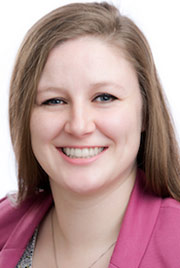Talking data: How community science informs conservation
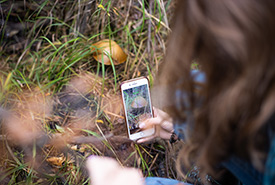
Volunteer capturing data with a smartphone at a NCC BioBlitz event (Photo by Brent Calver)
What comes to mind when you hear the word data? For many, data conjures ideas of numbers and computers, with scientists performing complex statistical analyses. While that generalization is reasonably accurate, it is important to understand that each of those numbers (or data points) represents something being measured for a specific purpose.
For example, the data points could be birds that are counted to determine their overall abundance or population change over time. Or perhaps the data points are quadrats (a square frame used to isolate a standardized area) in a vegetation survey that will be used to quantify a species’ habitat. The point is, in the field of ecology and conservation, the numbers in a spreadsheet represent specific things in the natural world. And collecting that data allows scientists to improve our understanding of how the world works, as well as explaining the mechanisms that drive trends or patterns observed in the data.
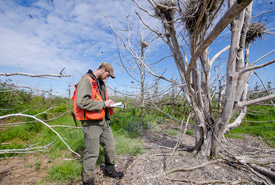
Josh Noseworthy records data amidst a double-crested cormorant rookery. The acidic cormorant excrement has killed a large portion of the spruce trees on Governor's Island, but they still provide excellent nesting habitat for cormorants and herons alike (Photo by Sean Landsman).
You often need quite a lot of data to be able to make meaningful inferences (a large sample size is needed to be able to reliably explain what is going on in the system you are investigating). As a result, data collection is often expensive in both time and resources. So, the question then becomes, how do scientists collect enough data to answer big picture or large-scale questions?
Volunteer-powered science
One way is through community science programs and with the help of volunteers! There are many community science projects that monitor a variety of different plants and animals, but there are a particularly large number of programs developed to monitor birds, in particular.
One of the best examples is the North American Breeding Bird Survey (BBS), which is where the population trend data for most species of birds in North America comes from. When you hear that grassland birds have declined by 53 per cent since 1970, that estimate of population change was derived from BBS data. What is particularly cool is that the data for the BBS is collected entirely by volunteers!
Collecting data over multiple years using the same methods and in the same locations is another way to build a large sample size. The BBS is an excellent example of a robust long-term dataset. Its data is reliable because it is collected using a standardized protocol along preset routes and is often completed by the same volunteer over multiple years. Using standardized protocols for data collection ensures that data is reliable and comparable across years and observers.
How you can get involved with community science
Developments in technology in recent years have made data collection easier and arguably more accessible. Many community science projects use apps to streamline data collection and eliminate manual data entry, which saves time and also reduces the chances of errors in the data. Two of the most well-known apps are eBird and iNaturalist; both are free apps that you can download onto your phone and that allow you to submit observations of birds and any wildlife you come across. Scientists use this data to learn about the life histories, occurrences and distribution of different species.
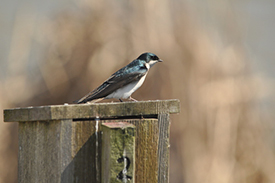
Tree swallow (Photo by Les Freck)
Personally, I participate in as many of these different monitoring programs as I can. I usually have my phone with me so it is super easy to start an eBird checklist before I go for a walk in the park and then record the birds I see and hear along the way (which, full disclosure, I’d likely be doing anyway).
It also only takes a few seconds to stop and take a photo of a wildflower to upload to iNaturalist. This allows me to slow down and take a closer look at the natural world around me. When I stop to take that photo of a wildflower, I notice the other different flowers nearby, as well as the bees and other little critters just going about their day. I appreciate noticing the little things like that and the quiet moments of reflection that result.
Every data point counts
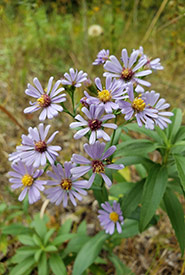
Smooth blue aster (Photo by Sarah Ludlow/NCC staff)
Perhaps my favourite part about participating in community science programs is that not only do I get some nice photos of flowers and some good observations of different birds, but I am also collecting data that will aid in their conservation.
I hope that you have been inspired to collect some data this summer! If so, here are some community science projects that could always use more participants (and data!):
- iNaturalist
- eBird
- Bumble Bee Watch – community science project to track bumble bee sightings in North America
- Journey North – community science project to track migration of monarch butterflies, hummingbirds and American robins in North America
- Zooniverse – online platform to digitally assist researchers with various projects worldwide
This list is by no means comprehensive, and there are community science projects across a wide range of topics —from astronomy to birds and bees to water quality — so a quick internet search is guaranteed to highlight a project that you can be excited about participating in. Just remember, your contribution is valuable, and every bit of data matters!

